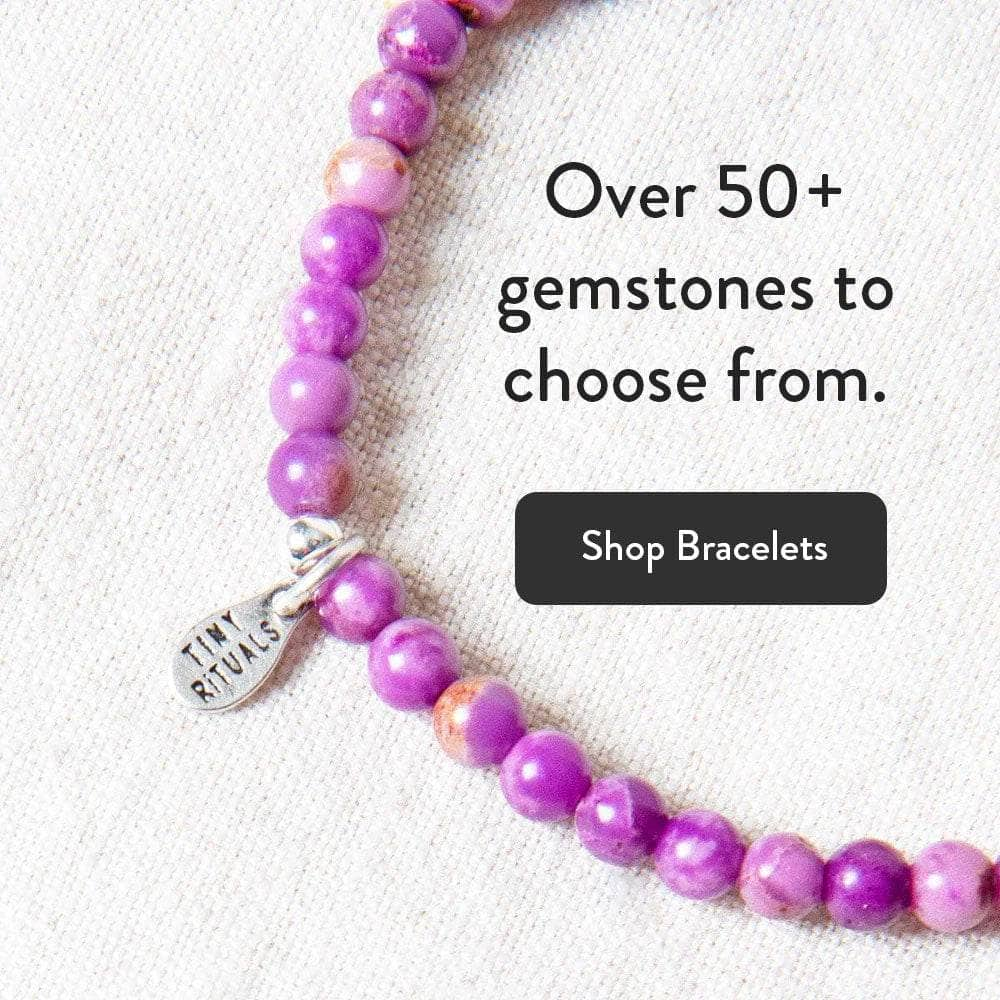
Are crystals rocks? A rock is a natural solid mass found in the earth and it is any two or more minerals bound together. While rocks can be composed of minerals and crystals, they are not actually crystals themselves.
After spending years immersed in the world of shimmering stones, magic minerals, and the high vibrations of healing crystals, we know it can get confusing trying to separate the differences between minerals, rock, and crystals. These terms are also often used interchangeably in the wellness world making it even trickier for us to know how to break down the science sometimes. Rocks, crystals, and minerals all share similar features, but they also have their own definitions too. To keep it super simple, we have a little breakdown below before delving deeper into the science and the differences that make each sparkling delight fall into its own unique category.
- A rock is made up of more than one mineral
- A crystal is a mineral with a crystalline structure (atoms that form a repetitive shape)
- A mineral is a solid inorganic substance that forms naturally
- A stone is a non-metallic mineral or rock
Gemstones

Check out our gemstone bracelets
Gemstones are always a joy. Flashing with color, humming with high energy, and soaked in healing style. A gemstone is a mineral crystal that has been cut and polished to make it more appealing to the eye. These pretty little gems are often used in jewelry but bring so much more than simple decoration. While we sometimes tend to associate gemstones with new age wellness trends or simply ornate additions, gemstones also have a long history with spiritual, emotional, and physical healing. Not all minerals get to sit under the banner of being a gemstone. Rarity, beauty, and durability all play a role when it comes to classifying gemstones which is why rubies, diamonds, sapphires make the cut whereas something like granite won’t. That’s not to say that all gemstones are precious or semi-precious stones, while they often come from a mineral base you can also get gemstones from an organic base too such as amber.
Crystals

Check out our crystal worry stones
Crystals are substances that have a crystalline structure. This happens when the atoms, molecules, and ions arrange themselves in a repetitive ordered three-dimensional pattern. These crystalline structures can happen quickly, or they can take thousands or even millions of years. A snowflake, salt, sugar, ice and sand all have a crystallized structure. Billions of atoms make up a crystal structure. These crystalline structures happen when a solid separates from gas or liquid and the atoms all gather tight together to make a structure. Crystals are also categorized by their shape of which there are seven different crystal structures which are - hexagonal, cubic, tetragonal, monoclinic, rhombohedral, and orthorhombic.
Some crystals can share the same chemical composition but the formation of the atoms within that crystal can change the result. Quartz crystals like Citrine, Amethyst, and Rose Quartz all share the same crystal structures but being exposed to changing temperatures, the addition of impurities, and natural tweaks to the chemical composition can all change the color or visual style of the crystal. The crystals we know and love can be formed underground in the mantle where magma and the earth’s crust meet to create cavities where crystals can form from the seepage of mineral rich fluids. They can form in rock cavities due to changes in heat, environment, or from surface water. There are crystals out there that we tend to call crystals despite them being something else – for example Lapis Lazuli falls under the classification of rock and Obsidian is considered to be a mineraloid.
Rocks

A rock is what you get when two different minerals bond together. Anyone who occupies planet earth knows that rocks are abundant, and they are one of the major players in the makeup of the world's outer layer. Rocks can break down into sand and soil and are an essential part of our whole ecosystem. Without rocks we wouldn’t have soil which would prevent plants from getting the water and oxygen they need to thrive.
There are three different types of rock;
Sedimentary rocks - formed over thousands of years by sediment being compressed by the oceans.
Igneous rocks - when volcanoes erupt and lava spews and spills before cooling into molten rock.
Metamorphic rocks - when intense geological forces cause metamorphic rock formation in the earth.
One of the simplest ways to think about rocks is to picture them being a solid mass made up of a thousand different grains and more than two bonded minerals. For example, it's common to find feldspars and quartz in granite rock.
Rocks start out as igneous but with time and changes in environment they are altered and can become metamorphic rocks. This metamorphism can cause a breakdown in the existing minerals and lead to the rock forming new minerals or combining with other minerals too.
Then of course we have geodes. Geodes are rock structures with internal cavities that can be lined with mineral materials and tiny quartz crystals. It’s common to find Amethyst, Calcite, and banded Agate inside geodes. There are also rarer examples of geodes out there that can contain pearly Opal or Rhodochrosite. Geodes look gorgeous and it’s no wonder that crystal lovers fall hard for them. Geologists love them for their fascinating makeup, but you don’t have to be an expert to be smitten by geodes. A rather dull rock broken open to showcase a multitude of dazzling hidden treasures inside.
Geodes can form in areas where there is a ton of volcanic activity. A simplified explanation is that spaces or voids where lava has flowed gets filled with minerals carried by water before crusting over. You can also get geodes from sedimentary rocks found in limestone and dolomites. What could have once been trees, roots, shells or any kind of organic material can leave a space after decay and these cavities can form minerals. These kinds of geodes tend to be on a smaller scale than the volcanic kind.
Minerals

Minerals are made up of inorganic solid matter. They all have a crystalline structure but are made from inorganic chemical composition. Minerals occur in the natural world and have a stable chemical composition and an organized internal structure with a repeating pattern. But not all minerals are crystalline and when they don’t have this crystalline structure they are known as mineraloids (again like Amber which is fossilized tree resin or Jet which comes from coal, or even pearl which is formed from shelled mollusks).
Plenty of minerals are made up of two or more chemical elements - for example the clear quartz crystal is made from atoms of silicon and oxygen. You can get minerals that are made up of single elements and this is where you get your precious metals - gold, silver, copper, titanium, and carbon are all single element minerals. There are thousands and thousands of minerals out there and every year at least 150 new kinds of minerals are uncovered.
Minerals make up both rocks and crystals, from fluorite to garnet, calcite and pyrite, there can be some overlap between crystals, rocks, and minerals but there are also major geological differences too.
The Differences

Minerals, rocks, gemstones, crystals - it can be a whirlwind to get your head around all the similarities and the differences. We have a quick summary between them to help set the record straight…
The Definition
Minerals are naturally occurring inorganic compounds. Crystals are solid materials with a repetitive microscopic structure. Rocks are naturally occurring solid masses that may contain both minerals and microscopic crystals too. Minerals tend to have a definite shape as do crystals whereas rocks have no definite shape and no definite chemical composition.
Structure
One of the most important points for understanding what makes a crystal a crystal in its nature is its very organized structure of atoms. From distance to angle, the crystal is all about that repetitive three-dimensional pattern compared to non-crystalline or amorphous solids (mineraloids) which have a random organization in structure.
How They Occur
Minerals are always natural whereas crystals can be synthetic, or lab grown, and certain types of rock can also be natural or manmade.
Chemical Nature
Minerals are always inorganic whereas crystals can be organic or inorganic. Rocks can also be organic or inorganic.
Hybrids

As mentioned, there can be lots of crossover in the world of the crystal, the rock, and the mineral and there can be hybrids too. Some of the most popular kinds of crystals can have rock stashed beneath the surface and vice versa. Here are a few examples of hybrids out there...
Lapis Lazuli is actually a rock and not a mineral. It takes its deep blue beautiful coloring from lazurite and is also flecked with small amounts of cloudy White Calcite and golden Pyrite too. This all adds to its dreamy color scheme and textured surface when in its raw form. The addition of Pyrite stops lapis from having its stone status.
Ametrine
Ametrine is a crystal and is composed of two different colored varieties of the quartz family. Amethyst is the purple hued crystal that is full of calm energy and Citrine is golden and bright. When Amethyst is heated it can turn into Citrine and in fact, heat-treated Amethyst makes up a major part of the Citrine market.
Unakite is made up of Epidote and Peach Feldspar and sometimes Clear Quartz which is what gives it that utterly unique swirled color scheme. Unakite is a form of granite which is technically a rock when it comes to chemistry classification.
Hematite is an iron oxide crystal. It is part of the trigonal crystal system. It is also considered to be a rock forming mineral, so it truly ticks all the boxes. It’s found in sedimentary, igneous, and metamorphic rocks across the world. It can flash silver in color or be sandstone shades of red and brown. Hematite is an important iron ore and one of the most abundant minerals to be found in the earth's shallow crust.
Understanding the differences between crystals, rocks, minerals and gemstones can give us insight into these treasures of mother earth. In the modern world of wellness and healing we may find these terms used interchangeably or the term crystal be used to describe gemstones and rocks that are aesthetically pleasing and full of healing power. Whether sparkling piece of quartz crystal, dark and dreamy glass obsidian, mineral rich fluorite, or geodes stuffed with amethysts, natural science sure is spectacular.
Did you know about these differences between rocks and minerals and crystals or is this news to you? Which do you think make the most beautiful crystals? Share all your gorgeous knowledge with us in the comments.




















